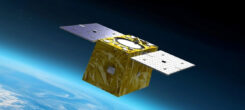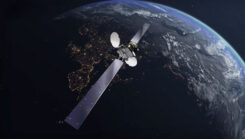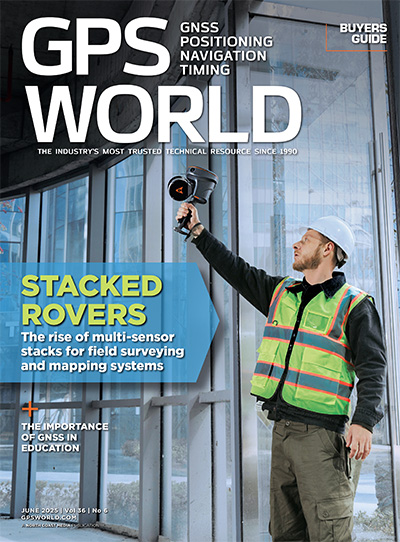Give the Users What They Want

 |
Providing a Position, Velocity and Time (PVT) service via a seamless global architecture, using the latest in satellite navigation systems technology, forms the basis of the GNSS concept. Galileo, designed as complementary to GPS, will provide broadly similar levels of services primarily for the civil, commercial, and scientific communities, and a group of additional services for which a need has evolved during recent years.
During 2000, the European Commission (EC) and the European Space Agency (ESA) conducted several definition studies for Galileo. The Galileo European Multimodal Integrated Navigation User Service (GEMINUS) and Galileo overall Architecture definition (GALA) studies explored user requirements and the commercial service opportunities, and examined ways in which a Public Private Partnership (PPP)/Private Finance Initiative (PFI) mechanism could develop service provision.
The Market. Broadly, the Galileo market comprises two main groups: mass market and professional users. Each would select Galileo services for different reasons and through different market mechanisms. The GEMINUS study identified several applications where Galileo services should prove attractive to future users. The five largest were:
- 1. Transport networks (mainly civil aviation)
- 2. Fleet management
- 3. Freight tracking
- 4. Consumer mass market
- 5. Personal emergency services.
The methodology to derive the future users’ true requirements was based upon market research and analyses of a number of specialist User Fora that produced three basic requirements for the transport sector:
- 1. a high technical performance of services (integrity, accuracy, continuity, and availability)
- 2. certification that signal specifications are met, enabling
- 3. a guarantee of performance, and an underlying liability scheme.
Service Definition . The Galileo service set should maximise the adoption of Galileo and enhance technological advancement in Europe. The EC has also established a design goal that Galileo services be interoperable with GPS to the greatest extent possible.
The approach to the derivation of Galileo services combines several parallel activities within GEMINUS, as shown in Figure 1. The diagram emphasises that the user requirements dominate the process.
The EC has now drawn together several views (GALA, GEMINUS, EGNOS integration into Galileo [INTEG], and so on) of the required service set and produced the Galileo Mission High Level Definition. The first EC-endorsed service definition, this document provides a firm basis for planning, involving the following core Galileo services.
The Open Service (OS). The OS is a global open-access service on two frequencies, free of direct user charges, that at least matches the expected capabilities of GPS and its evolutions. The use of single or dual frequencies in the user terminal would provide multiple levels of receiver performance. The OS signal is unencrypted.
The OS targets mass-market users. Third party services may be offered by combining or bundling basic services with other services (for example, position-related communications). Ultimately, considerations of cost, complexity, and potential revenue to the service provider will determine the choice of specific services on offer.
Safety of Life Service (SOLS). The SOLS provides improved integrity monitoring on a global basis, at least matching the performance and capability of current augmentation services (EGNOS, WAAS, and MSAS). Some nations or regions may generate regional integrity information separately, under their control; the system will also cater for these needs and provide direct integrity uplink capability. GEMINUS recommended that the SOLS should also become an open access service. SOLS may be offered in combination with global position communications. To achieve required accuracy and adequate redundancy, SOLS must have multiple frequency capability.
The SOLS targets requirements of the professional transport market, for example, safety of life–related applications for aviation, railways, and maritime operators. At the regional level, the aviation segment is foreseen as the most demanding and therefore the major driver for SOLS performance specification.
Commercial Services. Encrypted ranging and navigation data may be added to the OS to provide Commercial Services. The nature of these services at the global or regional level is still being studied, but several local area commercial services are firmly identified.
Local Area Augmentation Services (LAAS) at metric and centimetric levels and real-time kinematic services are assumed to be provided by local value-added service providers, not by the Galileo Operator, in response to market demand. The high cost of establishing a region-wide LAAS network to provide very high accuracy services against expected revenues from essentially niche markets dictates this view.
Encrypted data will be available within the open signals to assist in provision of these local commercial services, which will also use the third frequency, available for real-time kinematic and three-carrier ambiguity resolution (TCAR) operations.
LAAS, provided commercially by third parties, is expected to assist aircraft to land, ships to dock, and further enable extremely high accuracy services such as civil engineering services. Only the addition of LAAS can satisfy some of these high service requirements, such as the rail integrity one-second time to alarm requirement.
Time Service. Although not an identifiable discrete service, as it is extracted from the basic OS, the Galileo Time Service targets the specialised market for precise ranging and timing. Applications include timing, surveying and network management. Time users comprise two main groups: network synchronisation and time tagging. Galileo time could form the basis of a European legal time standard.
Public Services. To satisfy further public requirements, it is also anticipated that the EC will ask the Galileo Authority to operate some or all of the following services, still under study:
Integrated Augmentation. EGNOS is expected to be integrated, institutionally, commercially, and technically, into Galileo.
Public Regulated Service (PRS). The EC wishes to explore the possibilities of a global two-frequency PRS, for continuity of services to government users (civil security, police, firefighters, ambulances, and military) in times of crisis. The PRS is envisaged as an encrypted service on separate frequencies from other Galileo services.
Search and Rescue Service. Galileo is envisaged to have a Search and Rescue alerting capability, based upon an enhanced COSPAS-SARSAT capability, and adding a distress acknowledgement link.
Other Commercial Opportunities. A great opportunity exists for third parties to integrate navigation and communications, providing powerful infomobility and telematics capabilities.
The Navigation Related Communication Service (NRS), a 2-way data link, would provide short individual messages from millions of users to a great number of service providers, and short selective destination messages from service providers to geographically separated users. The proposed NRS providing basic data communication services related to navigation services, has a potential global coverage if the appropriate communications infrastructure is implemented worldwide, but it can support local/regional services equally well, for both public and commercial servicesusers moving within limited areas.
The current EC baseline assumes that the service will be run from existing terrestrial and satellite systems, though a Galileo satellite-based NRS communications payload is being studied.
Commercialisation
Galileo’s success will not only depend upon producing the specified technical capabilities on time and to budget but on its rate of take-up by European and worldwide users.
To stay close to changing user requirements during the 8-year period up to the launch of services, the programme must adopt a flexible signal structure and retain and refine the user forum groups already established, throughout the development/validation, deployment and operational phases. The forums will also facilitate market testing and promote the services as they develop.
This process must also include other players in service development, such as service providers, financial institutions, equipment manufacturers and the main industrial players. This process will also play a pivotal role in the commercialisation of Galileo services. To develop the markets for the services, the programme must incorporate a commercial consortium with strong user segment representation into the Galileo management process from the outset. We believe that an organisation should form to act as the Service Developer in this representation process.
The Galileo Service Developer. Only Galileo’s take-up by the user segment, and innovative applications implemented by those users, will constitute success for the programme. Should development lead to an expensive, over-elaborate system that misses its window of market opportunity, it would be deemed a failure.
The Galileo Service Developer (SD) is the one entity in the development process who will represent the interests of the user throughout that process. Why should the SD do this?
The SD will be an integral part of the Galileo Operating Company during all phases of development and deployment, alongside the EC and ESA. However, as the activities move beyond development, the SD would evolve to become the Operator, remaining after other companies have left. Upon the SD falls the responsibility for developing markets and delivering services.
The services should be provided under some sort of PPP or PFI concession contract from the organisation overseeing the Galileo project: the Galileo Agency. Therefore the SD must ensure that the services developed exactly match users requirements. For Galileo to succeed, the needs of the future customers/users and the eventual operator must drive the service design and architecture. These stakeholders must participate in programme implementation and management.
Without such involvement, commercial organisations will lack confidence in the final system and service, and markets may not develop. Industry would be reluctant to invest/participate in operating the system and services for many years. The Channel Tunnel project exemplifies this lesson; no train service operating company would buy the Channel Tunnel at its cost value. For the private sector to “buy” the offered investment opportunity, the system must have the required performance to satisfy customers and the correct pricing to provide a commercial return.
Services. To achieve these objectives, the SD must participate closely in these technical development tasks:
- 1. coordination of the mission consolidation;
- 2. creation of the Mission Requirement Document, particularly the service and signal requirements, including encryption regime, ranging signal, and navigation message structure and content;
- 3. definition of Galileo’s interoperability and compatibility criteria and interfaces with other nav and non-nav systems;
- 4. establishment of the mechanism enabling the certification process to begin;
- 5. standardisation tasks.
- 1. Develop the Galileo business case as part of the PPP and establish the PPP with the EU.
- 2. Form the Galileo Operating Company (GOC) with industrial and financial partners and evolve into a System Operating Company.
- 3. Establish open, non-proprietary standards, develop Galileo applications and technologies, and stimulate receivers/equipment manufacturers. The open GSM standard provides a model for an open standard that led to a high take-up.
- 4. Service Developer Advantages. The SD concept provides these advantages:
- 5. a shield from non-commercial forces
- 6. commercial involvement to strengthen the long-term Galileo project management structure
- 7. consultation with user communities, equipment manufacturers, and service providers to ensure that their demands/requirements are met.
Programme Commitments
Although the EC’s Cost Benefit Analysis Report identified E74 billion of net benefits to 2020, this will require considerable private sector work and investment to develop the markets that would realise the applications and services leading to these benefits. Commercial organisations typically invest 20 percent of revenues in research and development of new products and services. Studies to date have not taken these costs into account, so the EC is now updating the CBA.
Without the involvement of a major commercial participant (almost certainly a consortium) that has links to the key suppliers and customers throughout the entire supply chain, it is unlikely that Galileo will ever reach its full potential.
To achieve the funding profile envisaged by the EC requires some form of PPP for Galileo to go ahead. The three programme phases – Definition, Validation, and Deployment – call for different levels of commercial involvement and commitment.
Definition Phase, through 2001. The SD must be closely involved with the authorship of the Mission Requirements Document (MRD), forming the PPP consortium, and defining the Galileo services/system. Aspects include defining the Galileo signal, system interfaces and interoperability, certification issues, and developing user tools and techniques to validate future decisions.
Validation Phase, 2002-2005. To realise system potential, user needs must drive system specification and design, requiring a strong industrial role. The SD must understand the technical and business needs of the User Segment, and possess the expertise and track record to implement these aspects from the programme’s outset. Without such an involvement, the risk of system mis-specification and sub-optimal design remain high, and will affect the investment in the complete Galileo value chain of devices, applications and services.
The SD would seek to maximise Galileo uptake through its perception as the most open, developer-friendly system. Although seed money from the public sector will be required in the early stages, the private sector will undertake the vast majority of the financial responsibility for market development regarding receivers, applications and their markets. Financing by the private sector in this phase will exceed public sector outlay by an order of magnitude.
The SD would also negotiate the PPP for the transition to private financing and acceptance of risk between itself and the public sector. It would engineer the necessary financial and legal instruments (from the private side) and the funding required. Additional consortium partners may join the PPP consortium at this stage.
At the top level, the Galileo Agency (GA) will be responsible for public and international interests as well as regulatory/institutional issues (see Figure 2). The GA will take overall charge of Galileo, providing direction to the Galileo “Joint Undertaking,” whose major shareholders will be the EC, ESA and the SD. This entity will give credibility to Galileo, and its formation will attract private investment.
The Joint Undertaking has an Executive Board, composed of (say) 3-5 members each from EC, ESA and the SD, who will be responsible for the the development process, the business plan, and attracting private finance. It also protects the commercial interests of Galileo, acting as a buffer against political currents. From the Validation Phase onwards, this company will take over a managerial role, and become the Galileo Operating Company (GOC).
The second element of the SD’s role in this phase is its integrated project management in the role of Industrial Architect together with ESA. The aim is to complement ESA, not to overlap activities. Whereas ESA would be the prime technical authority, the SD would ensure that no design decision adversely affects Galileo services and marketability. The SD will focus on meeting the time-to-market for services and applications, and ensure that the programme schedule is met. The SD’s business development and marketing staff will be responsible for market and applications development and stimulating the receiver manufacturers as well as sub-contractors.
Deployment Phase, 2006-2007. From the beginning of this phase, the SD effectively becomes the all-private Galileo Operating Company (GOC), and could commit to accepting all of the programme risks except market risk (see Figure 3). Consortium members accept the technological risks, programme over-runs and launch failures, and so on. To this end, the GOC would undertake the complete cost of the Galileo Deployment Phase, through debt and equity issues. Clearly, the SD consortium must include space companies.
In return, the GOC would receive a guarantee of a fixed annual public sector service payment for the future annual cost of operations, maintenance and replenishment. We wish to clearly state that annual public service payments will be required to recover the costs of operations/maintenance and deployment.
Various techniques should exist to improve the basic concession agreement. By allowing for such later flexibility, there may be opportunities to generate revenues from services and activities that today appear unpromising or are not yet known. Only the presence of a commercial Galileo operator will provide incentive to exploit such new applications. The concession agreement should allow the public and private sector to share financially in any “upside.”
In the Deployment Phase, the SD has a limited role in the Industrial Architect aspect, as the system has by then been defined and specified. ESA will manage the system deployment, and the SD becomes synonymous with the GOC. The GOC will continue the market and business development role carried out earlier when the SD participated in the Industrial Architect role.
Operations Phase, 2008 Onwards. The GOC acts as the commercial satellite operator and market promoter of Galileo. It will maintain the concession agreement with the public sector (see Figure 4).
At this stage, the EC and ESA appear only in the GA role, overseeing the entire programme.
Conclusion
The services identified by EC Galileo studies indicate the need for a System Developer management structure for the Galileo programme. This will protect user requirements through definition and validation, and facilitate market uptake of Galileo services through deployment and operation, delivering a successful new GNSS. This approach will deliver the services users want.
;

















Follow Us